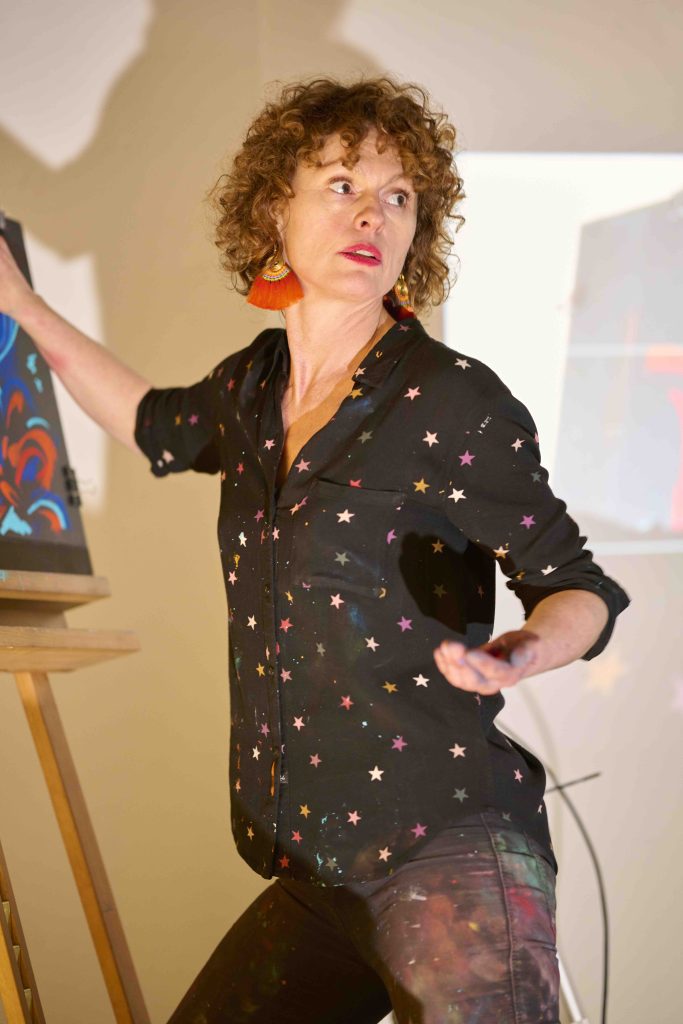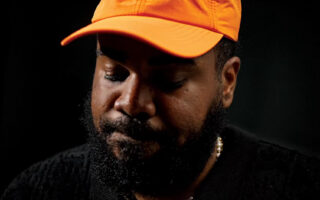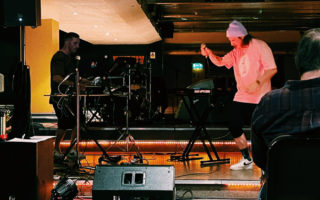
Gwendolyn Kassenaar, Conceptual artist
Gwendolyn Kassenaar is an artist who brings a fresh approach to uniting music and art in conceptual ways that encourage audiences to have new insights into how music interpretation can be accessed. I first saw Gwen when she performed with Noisy Women at Café Oto. Gwen spent time at her easel and vanishing behind the massive gong that sat centre stage. Finding inspiration, Gwen would run to her easel and depict incredible colour swathes and patterns, which I and the audience found fascinating. We could see her work on a large screen, but I wanted to find out more about the artist, so when she contacted me, I decided to take the opportunity to catch up with her. I finally managed to do this in a café in Russel Square to discuss her views on music, art, dance, and music.
Tell us a little about your background
I come from Amsterdam. As a child, we moved within the Netherlands. My parents were non-artistic I would say. My father was perhaps what I might describe as utilitarian. It took me a long time to find, or perhaps, allow myself to follow my heart’s path. My mother had a creative soul though and I remember as a child our dining table was always covered with craft materials, meaning we often could not eat there.
I studied business and went into corporate life. I never questioned this because I was brought up to think that is what one did. However, I found corporate life suffocating, and I remember leaving my jacket on my chair at work, so people believed I was still in the office, and sneaking out to art classes. I took drawing classes and found these incredibly fulfilling.
I moved to London and took evening classes at the Chelsea College of Art. I did all sorts, from pottery to colour theory and painting. Eventually, I decided to take the dive into art, and studied for a degree in spatial design. I found architecture fascinating and also life drawing.
How did improvised art and music come to be your focus?
I had done some screen painting in a studio and worked with patterns. I realised the music I had playing often influenced my work. For example, Brazilian jazz or Bossa nova. I realised music was in my work and began to use music and include instruments.
I met another artist, Aurelie Freoua, who invited me to do some live sketching at The Vortex. I began doing a lot of sketching at gigs. It felt fast, and creative, and I used many different mediums.
I took part in multidisciplinary performances at The Vortex and my drawings became more abstract based on sound. I participated in the ‘Freedom’ events at The Vortex with Orphy Robinson and soon felt part of the team.
Then came Covid and during the lockdown periods, I collaborated online with other performers and artists, and this proved an inspiring period. My work became more known. The act of creating work in real time with the music became part of these performances and felt amazing.
I worked with trumpeter and composer Loz Speyer, and we worked on performing with and without talking. So viewers could hear and see as I created work alongside music. Organically and unexpectedly, it grew to include more action on creation. I began to collaborate with people on stage, becoming part of the creative process of improvisation. This was unplanned but it grew.
I understand you see music and colours a little differently.
I have synaesthesia, so when I tune into music, it gives me colours, shapes, and animation in my mind’s eye. I am trying to capture this in still life, for the viewer, which can be tricky.
So how did you become involved with Noisy Women?
I worked with Steve Beresford who I knew from The Vortex and realised he lived relatively close to me. We began to meet up and discuss music and art. He introduced me to musician and improviser Faradena Afifi. We started talking during Covid with Magi Nichols and Marion Treby. Faradena asked me to join Noisy Women. The concept felt like a great idea and sounded interesting, so I thought ‘Why Not?’
Do you feel your journey has been different because you are a woman?
I think because of the part of the music industry I navigate I haven’t had any adverse experiences. I have in other areas, but not in improvised music. I am not interested in being sexy on stage, I am there to work.
Things can be misinterpreted. I wear bright red lipstick, for example. I wear it because I am celebrating life and joy. I am not interested in the male gaze, and I wear clothes to move in, so you will never see me wearing a dress on stage, for example.
To cope with stress, I advocate the five rhythms and movement method, for free movement (see below). This helps me to move on stage. When I was in business, you had to be careful around men, but I have not found this in music.
How does your work fit into family life?
I am a Mum to two children, one boy and one girl. When I first became involved with music, I didn’t tell people I was a Mum because there was a mistaken belief I would be taken less seriously. This is something I have not found to be so. Being a mother does curtail some things, like being able to take off on tours for example but it is now easier as my children are older. My children are supportive of what I do.
What is your vision for the future?
I have lots of ideas and it is a question of prioritizing and deciding which to follow.
Something that has affected me is that a while ago I had a fall that resulted in a brain injury, so I was healing in bed for a month. I found the sensory deprivation difficult. It also changed my synaesthesia, and I began to tune into the sounds of daily life such as cars, birdsong, and so on.
When I was able, I went to the park and sketched to try to get the sounds on paper. I want to do something in the future about healing.
I was offered pills and medication to help heal but I did not want to take a lot of things, so I healed through yoga and meditation to help my balance. I believe strongly in the power we have to heal ourselves and would like to create a body of work to express that.
With music, I remain open and curious. I would like to maybe experiment with classical and orchestral music and find different ways of expressing life.
I recently did a trial with Noisy Women where there were three dancers and would like to go further with this.
This experience with the dancers was interesting. It was about liberating the painter from a fixed spot. Often I am on stage off to one side painting. The audience can see what I am doing because there is a screen, but this idea was the dancers each had a small canvas attached to their forearms. I painted as they moved through the space, using the canvases on their bodies. So I was dancing and moving with them. Sometimes the canvas might be above me, or below me, and sometimes reaching to paint as they moved was tricky, but it was a brilliant concept. It introduced the chance mechanism with the changing position of the canvases.
Each morning I go to the garden and practice sitting meditation. I listen to sounds, both natural like birdsong, and man-made like cars, or building work. I am obsessed with colour.
Gwen proved hugely engaging interviewee. We talked of things outside the scope of the interview and her whole being speaks of colour and vibrancy, from her dress sense, to how she moves and speaks. There is an energy about Gwen that I feel sure those who engage with her concepts and ideas will find impossible to resist and I am certain she is an artist we shall see and hear more from.
The 5 Rhythms is a movement meditation practice devised by Gabrielle Roth. It draws from shamanistic, ecstatic, mystical, and Eastern philosophies alongside different therapeutic and psychological practices. Essential is the belief that energy moves in patterns, waves, and rhythm.



